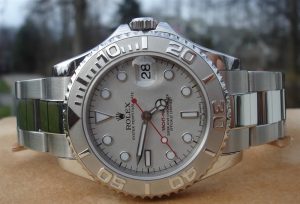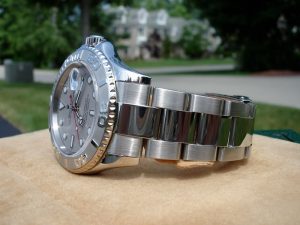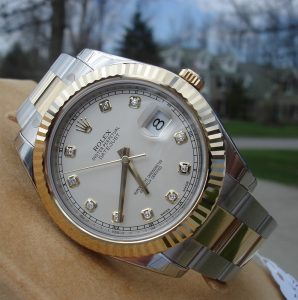Rolex are always the most best replica watches all over the world. It seems that every innovation brought out by the brand, of which there are plenty, keeps fans satisfied for a little while before the clamoring starts up again for the next big thing. The GMT-Master is a case in point. When the original version was established in 1953, it became the first watch to simultaneously display two time zones and was aimed very much at airline pilots—more precisely Pan Am, who collaborated on the design to help their long haul flyers deal with jet lag.
The two-tone bezel, half blue and half red, was a gorgeous way for wearers to determine between night and day at a glance and also gave the watch its signature look. An immediate success, the watch went through only relatively superficial upgrades over its lifespan until the ‘Fat Lady’ appeared in 1983, the unofficial nickname for the first of the new era of GMT-Master II’s. 

It is now so far, so good. However, the anodized aluminum replica Rolex had been using for their bezels after the original Bakelite proved too brittle, while exceptionally strong, was still subject to scratching and fading over time. The solution was for the company to find their own replacement ceramic material, Cerachrom. Practically indestructible, Cerachrom has no effects by sunlight or the rigors of exposure to chlorinated or sea water.
The problem with the new ultra-tough Cerachrom was that it makes it so harder material to work with and, impossible to add a bi-color scheme to when it come to the replica Rolex themselves. When the first of this new breed was unveiled in 2005, the much-loved ‘Coke’ and ‘Pepsi’ models, and the golden brown of the ‘Root Beer’, had been replaced with a uniformly black bezel.
While there are sections of swiss Rolex supporters, and specifically GMT-Master collectors, who intentionally find out the more weathered-looking models, other enthusiasts feel that if the unorthodox colors were the reason you chose the watch at the very first beginning, you’d want them to stay as close to their original luster for as long as possible.
This anniversary model was beautifully elegant, which is all gold with a dial in Rolex’s trademark green, but some felt this ‘Lunette Noire’ GMT was missing the very thing that made the piece so instantly recognizable in the first place. A two-tone bezel was conspicuous by its absence to a large extent.
The steel version available today was introduced in 2007 and features many upgrades on its predecessor both inside and out. The new maxi dial improves the watch’s legibility with fatter hands and markers on the outside, band the larger case and Triplock crown gives it a look bigger than its actual 40mm.
There’s no word on how long Rolex replica were actually working on the problem of coming up with a dual-color ceramic, but as you would expect, it is a technically impressive exercise. Starting out entirely blue, the process involves masking off half of the bezel, before exposing the other half to a Rolex patented chemical process to achieve the black coloring. It’s a typically flawless shift between the two tones, with no hint of a bleed or any blurring where the lines fuse. 
If history tells us anything, it’s that the Rolex’s that stray from the ‘norm’, the ones with unconventional takes on classic designs, are the models that become the most sought after a few years down the line. With the reissue of the characteristic red and blue Pepsi color scheme of the GMT-Master II in Cerachrom just a year after The Batman made his appearance, the blue/black version is surely destined to become a hot favorite for avid collectors.